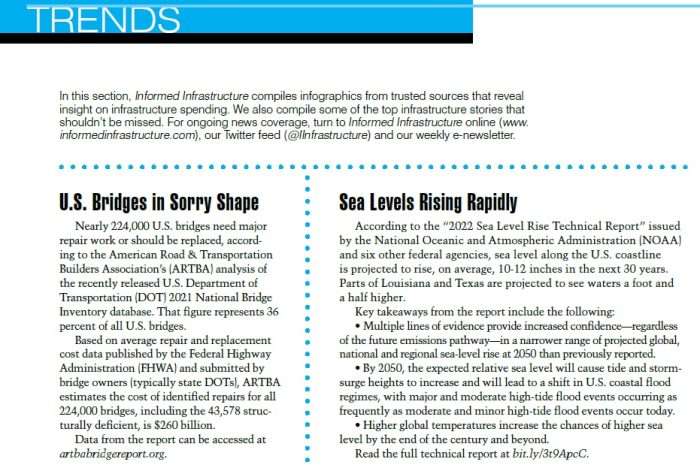April 2022 Trends

U.S. Bridges in Sorry Shape
Nearly 224,000 U.S. bridges need major repair work or should be replaced, according to the American Road & Transportation Builders Association’s (ARTBA) analysis of the recently released U.S. Department of Transportation (DOT) 2021 National Bridge Inventory database. That figure represents 36 percent of all U.S. bridges.
Based on average repair and replacement cost data published by the Federal Highway Administration (FHWA) and submitted by bridge owners (typically state DOTs), ARTBA estimates the cost of identified repairs for all 224,000 bridges, including the 43,578 structurally deficient, is $260 billion.
Data from the report can be accessed at artbabridgereport.org.
According to the “2022 Sea Level Rise Technical Report” issued by the National Oceanic and Atmospheric Administration (NOAA) and six other federal agencies, sea level along the U.S. coastline is projected to rise, on average, 10-12 inches in the next 30 years. Parts of Louisiana and Texas are projected to see waters a foot and a half higher.
Key takeaways from the report include the following:
• Multiple lines of evidence provide increased confidence—regardless of the future emissions pathway—in a narrower range of projected global, national and regional sea-level rise at 2050 than previously reported.
• By 2050, the expected relative sea level will cause tide and storm-surge heights to increase and will lead to a shift in U.S. coastal flood regimes, with major and moderate high-tide flood events occurring as frequently as moderate and minor high-tide flood events occur today.
• Higher global temperatures increase the chances of higher sea level by the end of the century and beyond.
Read the full technical report at bit.ly/3t9ApcC.
According to a new report released on March 3, 2022, by Bloomberg New Energy Finance, solar and wind energy grew last year at the fastest rate in the history of the United States, and now accounts for a record 13 percent of the country’s power generation (bcse.org/factbook).
Renewable energy production in the United States, obtained from hydroelectric dams, wind turbines and solar arrays, grew more than 4 percent last year, and—together with nuclear energy—met 40 percent of United States’ demand for carbon-neutral energy sources.
Natural gas remains the largest source of U.S. electricity generation (38 percent), and power from coal-fired plants increased slightly in 2021 (to 22 percent).
World Economic Forum Pushing for ‘BiodiverCities’
“BiodiverCities by 2030: Transforming Cities’ Relationship with Nature” is a joint initiative of the World Economic Forum and the Alexander von Humboldt Institute to support city governments, businesses and citizens to enable cities to live in harmony with nature by 2030.
The report (bit.ly/37zd8c5) articulates the opportunity for urban leaders and citizens to transform their cities’ relationship with nature through key messages:
• Exponential growth of the global built environment undermines nature’s critical contributions to our societies and economies. Business as usual is no longer an option.
• BiodiverCities by 2030 sets a vision of cities as living systems, where their economic, social and ecological functions come together in harmony.
• By shifting investment to nature-based solutions for infrastructure, cities can build a climate-resilient built environment while lessening their impact on biodiversity.
• Expanding nature in the built environment creates significant economic and social value.
TOP Stories
The following are the top stories from the last few months (in terms of traffic) on the Informed Infrastructure website. This also reflects key coverage areas that are regularly refreshed online and via our weekly e-newsletter. Simply search key words on Informed Infrastructure online to find the full story.
Buildings
- New Sustainable Hybrid Sandwich Elements Combine Concrete and Wood
- GSA & DOE Seek Technologies for Net-Zero Carbon Buildings
- MdeAS Breathes New Life into Historic McGraw-Hill Building at 330 West 42nd Street
- Stora Enso Launches Low-Carbon Industrial Buildings Solutions for UK
- Updated ASCE 7-22 Standard Now Available
Transportation
- SPMT Cantilever Solution Allows for Swift Setting of Rail Bridge Girders in Colorado
- FAA Invests $479.1M in Safety, Sustainable Infrastructure at Airports
- Acrow Bridges to Restore Critical Transportation Infrastructure in Honduras
- Video: ‘Driving’ Innovation To Help Eliminate Plastic Waste
- Sustainable Aviation Fuel Delivery at Dallas Fort Worth International Airport Marks Industry’s First Demonstration of Circular Economy in the United States
Water
- EPA and DOI Announce Recommitment to Federal Partnership in Support of Urban Waters
- Idrica Develops World’s First 5G-NR Device Specifically for the Water Industry
- Ferguson Waterworks Partners with Trimble to Offer Utilities Greater Access to Technology for Digitizing Water and Wastewater Assets
- Burrowing Critters Increase Risk of Levee Failure
- GLWA Increasing System Resiliency with Improvements to 14 Mile Transmission Main
Tools and Technology
- Federal Highway Administration Unveils Infrastructure Investment and Jobs Act ‘One-Stop Shop’ Website, Publishing Request for Information
- Trimble’s New GNSS Base Station Gives Users Improved Satellite Tracking and Remote Operation for Civil Construction, Geospatial and Agriculture Applications
- Nemetschek Group Announces Strategic Investment in Norwegian Start-Up Imerso
- Propex Launches New Engineered Mattress System for Scour and Erosion Protection
- International Public Works Professionals Select Top Five Trending Technologies for 2022


